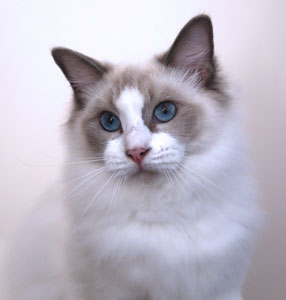Ragdoll

In the 1960s a regular non–pedigreed white domestic longhaired cat named Josephine, who had produced several litters of typical cats, was injured in an accident involving a car and taken to the veterinary hospital at the University of California. Josephine was of a Persian/Angora type and had litters sired by several unknown male Birman or Burmese–like cats, one of which had the Siamese point coloration. Baker believed that Josephine was subject to a secret government genetic experiment during treatment at the lab, and claimed that it made Josephine docile, relaxed when picked up, and immune to pain. After Josephine recovered, her next litter produced kittens with similar temperament. When the subsequent litter produced more of the same, Ann Baker (an established cat breeder) purchased several kittens from the owner, who lived behind her, and believing she had something special, set out to create what is now known as the Ragdoll. The breed was selectively bred over many years for desirable traits, such as large size, gentle demeanor, and a tendency to go limp when picked up, as well as the striking pointed coloration.
Out of those early litters came Blackie, an all black Burmese–like male and Daddy Warbucks, a seal point with white feet. Daddy Warbucks sired the founding bi–color female Fugianna, and Blackie sired Buckwheat, a dark brown/black Burmese–like female. Both Fugianna and Buckwheat were daughters of Josephine. All Ragdolls are descended from Baker's cats through matings of Daddy Warbucks to Fugianna and Buckwheat.
Baker, in an unusual move, spurned traditional cat breeding associations. She trademarked the name "Ragdoll," set up her own registry—International Ragdoll Cat Association (IRCA)—and enforced stringent standards on anyone who wanted to breed or sell cats under that name.[2] The Ragdolls were also not allowed to be registered in other breed associations. In 1975, a group led by Denny Dayton broke rank with IRCA with the aim of gaining mainstream recognition for the Ragdoll. This group eventually developed the Ragdoll standard currently accepted by major cat registries.
Since the spread of the Ragdoll breed in America during the early 1960s, a breeding pair of Ragdolls was exported to the UK. This was followed by eight more cats to fully establish the breed in the UK, where it is recognised by the Governing Council of the Cat Fancy
In 1994, a second group decided to leave the IRCA and form their own group due to increasingly strict breeding restrictions. This group later established the Ragamuffin breed. Because Baker owned the rights to the name "Ragdoll", no offshoot groups could call their cats Ragdolls until the trademark on "Ragdoll" was not renewed in 2005.
Laid back and quiet with a very placid disposition. Although not a skittish cat, Ragdolls do have their active moments and enjoy a play. These cats however don't display strong hunting instincts and are happy to lounge around waiting for some loving attention. Ragdolls aren't a demanding cat and are not regarded as a vocal breed like Siamese. Tolerant of children and strangers, the Ragdoll makes an ideal pet for owners who have visitors or children dropping by.
The Australian Cat Federation Inc standard for the breed can be found here.
